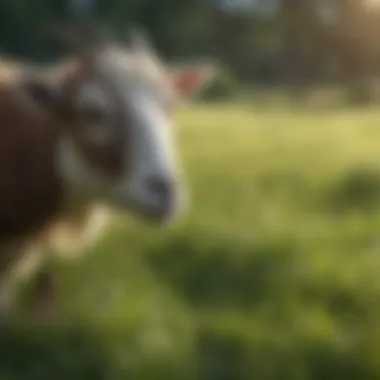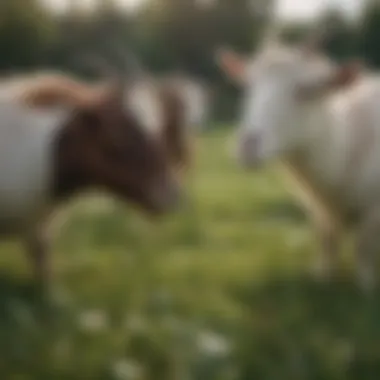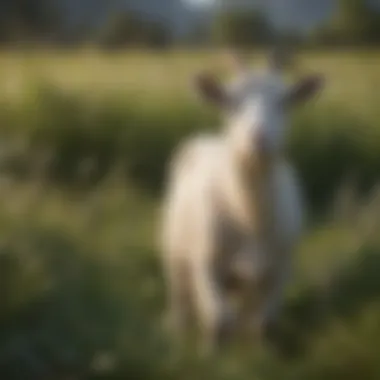Grasses for Goats: Essential Guide to Optimal Nutrition


Intro
Understanding the right grasses for goats is crucial for optimal livestock care. This guide will delve into different grass species that cater to the dietary needs of goats. Knowing about the nutritional value and growth conditions of these grasses can enhance not only goat health but also productivity.
The choice of forage impacts goat well-being directly. As goat owners, farmers, or enthusiasts, one must grasp how forage quality can affect the overall efficiency of raising goats. This overview intends to clarify various aspects of effective grazing practices suited for goats.
Nutritional Value of Grasses
Grasses constitute a primary component of goat diets. The right selection can ensure your goats receive essential nutrients. Various grass types offer different benefits:
- Timothy Grass: High in fiber, it supports healthy digestion.
- Orchard Grass: A good source of energy and palatable for goats.
- Bermudagrass: Thrives in warm climates and is rich in nutrients.
Understanding these grasses and their specific nutritional profiles can inform decisions about grazing and supplementation.
Growth Conditions for Grasses
Growth conditions significantly influence the quality of grass. Key factors include:
- Soil Quality: Grass needs well-aerated soil with proper pH levels.
- Water Availability: Consistent moisture promotes better growth.
- Sunlight Exposure: Most grasses require full sun for optimal growth.
Choosing the right species based on your climate and soil conditions can yield better forage quality.
Management Practices
Effective management practices enhance forage quality.
- Rotational Grazing: This technique allows grasses to recover and grow.
- Weed Control: Maintaining a weed-free environment improves grass health.
- Soil Testing: Regular testing can identify deficiency and guide fertilization needs.
Employing such techniques leads to sustainable grazing, ensuring your goats have access to high-quality forage.
Impact on Health and Productivity
Grass quality directly correlates with goat health and productivity. Poor quality forage can lead to nutritional deficiencies, affecting growth, reproduction, and milk production. Conversely, high-quality grasses can enhance:
- Weight Gain: Goats thrive better on nutritious forage.
- Reproductive Health: Proper nutrition supports breeding and kidding.
- Overall Energy Levels: Healthy goats are active and productive.
Promoting a well-rounded diet through diverse grasses contributes to overall goat well-being.
Epilogue
Understanding Goat Nutrition Needs
Understanding goat nutrition needs is fundamental for optimizing their health and productivity. Goats are unique grazers with distinct dietary requirements. Recognizing these needs can help farmers and goat owners make informed decisions about feeding strategies. This section will delve into the critical elements of goat nutrition, emphasizing forage's central role, essential nutrients, and the overall impact of proper diet on goat well-being.
Importance of Forage in Goat Diet
Forage forms the backbone of a goat's diet. It offers the necessary fiber that supports digestive health. Goats have complex digestive systems that require adequate forage to function properly. High-quality forage promotes rumen health, enhances nutrient absorption, and aids in maintaining a balanced gut microbiome. Without sufficient forage, goats may develop digestive issues, leading to illness.
Moreover, forage contributes to a goat's behavioral health. Grazing is a natural behavior for goats, and providing forage allows them to express this instinct. A diverse forage base also encourages foraging behavior which reduces stress and improves overall well-being.
Key Nutrients for Goats
Proteins
Proteins are vital for growth, reproduction, and milk production in goats. They are composed of amino acids, which are necessary for building tissues and muscles. The specific aspect of proteins significant for goats is their role in supporting bodily functions and enhancing growth rates in kids.
Goats require a diet rich in high-quality protein sources, such as legumes or supplemented grains. This helps satisfy their metabolic demands and supports efficient growth or milk yield. However, excessive protein can lead to health issues, such as urinary calculi in males; thus, careful monitoring is essential.
Vitamins
Vitamins play a crucial role in various biochemical processes. They support metabolism, immune function, and reproductive health. Goats, like other livestock, need essential vitamins, especially Vitamins A, D, and E. These vitamins contribute to overall health and replace nutrients lost during grazing.


Goats may struggle to synthesize certain vitamins on their own, making supplementation necessary, especially in winter or less nutritional pastures. Conversely, an excess of vitamins can also lead to toxicity, so balancing this intake is critical to avoid health complications.
Minerals
Minerals are another key nutrient category essential for goats. They are important for bone health, nerve function, and muscle contraction. Key minerals for goats include calcium, phosphorus, magnesium, and salt. They have distinct functions, like calcium and phosphorus working together to maintain healthy bones.
While goats may find these minerals naturally in their forage, added supplementation is often beneficial, especially in less nutrient-rich soils. Over-supplementation can lead to imbalances, so having precise mineral requirements for your goat's specific needs is essential.
Role of Grasses in Goat Health
Grasses play an integral role in maintaining goat health. Not only do they supply essential nutrients, but they also contribute to a balanced diet. Diverse species of grasses offer various vitamins and minerals, enhancing the overall nutritional profile available to goats. Grazing on different grass types can prevent nutritional deficiencies and support the immune system. Access to grass can also help regulate body weight and promote healthy growth, further underscoring the need for selecting appropriate grass varieties for grazing.
In summary, understanding goat nutrition needs, particularly the importance of forage and the key nutrients required, is essential for optimal health and productivity. Properly managing these factors leads to healthier goats and better outcomes in farming practices.
Types of Grasses Suitable for Goats
In understanding what grasses are best for goats, one must consider their unique dietary needs. The type of forage chosen impacts not just the health of the goats but also their productivity. Selecting the right grasses can lead to improved weight gain, enhanced milk production, and overall better health. The following sections will explore specific types of grasses, including their growth habits and nutritional profiles, ensuring that goat owners can make informed decisions to benefit their livestock.
Cool-Season Grasses
Cool-season grasses thrive in cooler temperatures, usually in spring and fall. These grasses are important for regions that experience seasonal changes. They are crucial for goat diets during cooler parts of the year when other feed sources may be limited.
Timothy Grass
Timothy Grass is a popular forage choice for goats. It is well-regarded for its high fiber content which aids in digestion. This grass is rich in nutrients, making it a beneficial choice overall. Its palatable taste encourages goats to consume it eagerly.
One unique feature of Timothy Grass is its three growth stages which range from vegetative to mature. Each stage offers a different nutrient profile, allowing for a varied diet throughout the growing season. However, it can become coarse when over mature, which may reduce its palatability for some goats.
Bermudagrass
Bermudagrass is another cool-season option. Its dense growth and resilience make it a popular choice for many goat owners. This grass is low maintenance and can withstand grazing pressure well. It offers a good amount of nutrients that goats require.
A distinct characteristic of Bermudagrass is its ability to grow in a variety of soil types. This adaptability makes it a valuable grass for diverse geographic areas. However, it may require more frequent mowing or grazing to prevent it from becoming too tall, which can diminish its quality.
Warm-Season Grasses
Warm-season grasses flourish in warmer weather, particularly during summer months. These grasses play an essential role in ensuring goats have enough forage during hot periods when cool-season grasses may not be as abundant.
Fescue
Fescue is a significant warm-season grass that many goat farmers cultivate. It is hardy and can establish quickly, making it ideal for rapid coverage. The grass can tolerate drought conditions better than some other types.
Fescue contains certain endophytes that can affect goat health negatively if consumed in large quantities. It is critical for farmers to be aware of the specific strains they are planting. However, when managed correctly, it still provides good forage quality.
Orchardgrass
Orchardgrass is favored by many goats due to its fine texture and high palatability. This grass provides a rich source of energy due to its carbohydrate content. Its growth habit allows for continuous grazing, making it sustainable for livestock.
Its unique feature is its ability to grow well in shaded areas, unlike some other grasses. However, moisture retention can be an issue when growing Orchardgrass, requiring attention to irrigation needs.
Legumes vs.
Grasses
While both legumes and grasses can be beneficial for goats, they serve different purposes in the diet. Legumes like clover contain higher protein levels compared to grasses. They are excellent for supplementing a goat's diet, particularly during periods of high demand like lactation or growth. On the other hand, grasses provide critical fiber which is necessary for digestion and overall health. A well-balanced diet incorporating both legumes and grasses ensures goats receive the nutrients they need.
Benefits of Grass Grazing for Goats
Grass grazing is crucial for goats, serving as a natural and sustainable method to provide essential nutrition. Understanding the benefits can help farmers and goat owners optimize the health and productivity of their livestock. The importance of grass grazing extends beyond basic feeding; it encompasses economic viability, animal health, and environmental sustainability.
Economic Aspects


The economic benefits of grass grazing are significant. Grazing can substantially reduce feed costs for goat owners. When goats graze on pasture, reliance on purchased feeds decreases, resulting in lower operating expenses. This aspect is essential for both small-scale and commercial farmers.
- Cost Efficiency: Grazing lowers the need for stored feed, which can be expensive.
- Land Utilization: Effective utilization of land can increase productivity. Land that is properly utilized for grazing can result in higher yields and more healthy goats.
- Sustainable Practices: Adopting grass grazing practices can improve soil health, enhancing future productivity and reducing the need for artificial inputs.
In summary, integrating grass grazing into goat farming practices can create a more sustainable economic model.
Health Benefits
Grass grazing contributes to the overall health of goats. The diverse nutrients found in grasses play a critical role in maintaining the well-being of these animals.
- Balanced Diet: Grazing allows goats to consume a variety of grasses, providing essential nutrients necessary for growth and development.
- Improved Digestion: Natural foraging encourages better digestion and gut health. Grazing promotes a healthier rumen environment.
- Mental Stimulation: Grazing also offers goats the chance to engage in natural behaviors, contributing to better mental health.
Healthy goats are productive goats.
Ultimately, the health benefits of grass grazing are substantial. From better digestion to improved overall well-being, a well-managed grazing system is essential for optimal goat care. This highlights the importance of understanding how to incorporate suitable grasses into their diet for maximum health benefits.
Ideal Growing Conditions for Goat Grasses
Understanding the ideal growing conditions for grasses suitable for goats is essential for promoting their health and maximizing forage yield. Grasses are not only a primary food source for goats but also contribute to their overall well-being. By ensuring that these grasses thrive under the right conditions, goat owners can improve the nutritional value of their livestock's diet and enhance their productivity.
Soil Requirements
Good soil health is crucial for the growth of any type of grass. For goat grazing, the following soil characteristics should be monitored:
- pH Level: Most grasses prefer a pH level of 6.0 to 7.0. If the soil is too acidic, corrective measures such as liming may be necessary.
- Nutrient Content: Soil should have adequate levels of key nutrients like nitrogen, phosphorus, and potassium. Regular soil testing can identify deficiencies and help in selecting appropriate fertilizers.
- Drainage: Proper drainage is vital. Waterlogged soils can lead to root rot, which affects grass health.
Having healthy soil not only encourages grass growth but also promotes biodiversity in the pasture. This can lead to a more resilient ecosystem, ultimately benefiting the goats that graze on it.
Climate Considerations
Climate plays a significant role in determining which grasses will flourish. Consider the following aspects:
- Temperature: Different grass types have varying temperature preferences. For instance, cool-season grasses thrive in cooler climates, while warm-season varieties do best in warmer conditions.
- Rainfall: Adequate moisture is essential for grass growth. Regions with inconsistent rainfall might require irrigation systems to ensure a steady supply of water.
- Sunlight: Grasses need sufficient sunlight for photosynthesis. Aim for pastures with at least six hours of sunlight per day.
Managing these climate factors can lead to a sustainable grazing environment where grasses remain healthy and provide optimal nutrition for goats.
In summary, prioritizing soil health and understanding local climate conditions are fundamental when growing grasses for goats. These elements work together to create a productive pasture that supports the nutritional needs of the goats and enhances their overall health.
Management Practices for Goat Grazing
Effective management practices are crucial for optimizing goat grazing. These strategies not only improve forage utilization but also enhance the overall health and productivity of goats. Proper management ensures that goats have consistent access to high-quality grasses, which is essential for their nutrition. Additionally, managing grazing properly can lead to healthier pastures, which support a more sustainable farming environment.
Rotational Grazing Strategies
Rotational grazing is a method characterized by moving goats between different grazing areas. This practice allows for the rest and regrowth of grasses and other plants in pastures. Benefits of this approach include:
- Improved forage quality: By allowing grasses to regrow, goats have access to fresher and more nutritious options.
- Reduced overgrazing: This method prevents specific areas from being overgrazed, which can lead to soil erosion and degradation of the land.
- Enhanced pasture health: Increased biodiversity occurs as different plants take root, contributing to a more resilient ecosystem.
Implementing a rotational grazing strategy can be straightforward. Farmers should designate several paddocks and rotate their goats between them. This not only benefits the land, but also promotes better health among the goats. They tend to be less stressed and experience fewer health issues when not exposed to the same area continuously.
Weed Control Methods
Controlling weeds is an important aspect of goat grazing management. Weeds can compete with desirable grasses, leading to lower pasture quality. There are various methods to manage weeds in grazing areas:
- Mechanical control: This includes using equipment or manual methods to cut or remove weeds before they seed and spread.
- Chemical control: Herbicides can be applied selectively to target problem weeds while preserving grass species.
- Grazing management: Setting grazing schedules can prevent specific weeds from going to seed, limiting their spread.
Effective weed control contributes to maintaining the quality of grasslands. Healthy pastures lead to better nutrition for goats, which ultimately translates to improved growth rates and production levels. Regular monitoring of pastures and adapting management strategies is essential for successful weed control and overall grazing management.
Proper management of goat grazing is not just a good practice; it's an investment in your livestock's health and productivity.
Challenges in Grass Cultivation for Goats


Cultivating grasses for goats presents various challenges that must be understood and addressed to ensure a healthy and sustainable grazing environment. These challenges can affect not only the yield and quality of the forage but also the overall health and productivity of the goats. Consequently, it is critical for goat owners and farmers to anticipate these obstacles and implement effective strategies.
Pest Management
Pests pose a significant threat to grass cultivation intended for goat grazing. Insects such as grasshoppers, cutworms, and armyworms can quickly decimate grass stands if not controlled. In addition to insects, rodents and larger animals may also disrupt growth and forage availability.
To manage pests effectively, it is essential to deploy an integrated pest management (IPM) approach. This strategy involves monitoring pest populations and applying targeted treatments only when necessary. Common techniques include:
- Biological Control: Utilizing natural predators or parasites to reduce pest populations.
- Cultural Practices: Rotating crops and planting cover crops to disrupt pest life cycles.
- Chemical Methods: Judicious use of pesticides as a last resort, ensuring compliance with guidelines to minimize chemical residues.
Educating goat owners on the significance of pest management creates awareness around preventative measures. This knowledge aids in maintaining a productive environment for grass growth.
Effective pest management can enhance forage quality and protect the health of goats, ultimately leading to improved productivity and economic returns.
Environmental Factors
Environmental constraints play a pivotal role in grass cultivation for goats. Factors like soil quality, temperature, and rainfall directly influence grass growth. If these conditions are not optimal, grass performance can suffer.
Soil Quality
Soil requirements include nutrient availability, pH levels, and drainage capabilities. Well-drained, nutrient-rich soil encourages healthy grass growth. Testing soil regularly can identify deficiencies that need addressing, which might include:
- Adding Organic Matter: Incorporating compost or well-rotted manure to improve soil structure and nutrient content.
- Appropriate pH Adjustment: Applying lime or sulfur based on soil tests to achieve optimal pH levels, usually between 6.0 and 7.0 for most grasses.
Climate Considerations
Climate factors are also instrumental in grass cultivation. Different grass species have varying tolerances to heat, cold, and drought. For instance, cool-season grasses flourish in moderate temperatures and can struggle during hot summers, while warm-season grasses are better suited for hotter conditions.
Understanding local climate patterns helps farmers select appropriate grass species for their specific region. This knowledge ensures that the grass can thrive and provide adequate forage for goats.
Innovative Techniques in Grass Farming
Innovative techniques in grass farming are essential for modern goat husbandry. Sustainable practices can significantly enhance forage growth and improve the quality of grass consumed by goats. For farmers and goat owners, integrating new methods not only improves animal health but also optimizes resource use and increases productivity.
Hydroponic Grazing Solutions
Hydroponic grazing solutions represent an advancement in producing nutritious forage without traditional soil-based farming. This method involves growing grass in a nutrient-rich water solution, allowing for faster growth rates and higher nutritional content.
Benefits of hydroponic systems include:
- Space Efficiency: Hydroponics can be set up in compact areas, making it ideal for urban or smaller farms.
- Year-Round Growth: With controlled environments, farmers can grow grass regardless of season or weather conditions.
- Nutrient-Rich Forage: Because nutrients are directly provided to the grass roots, the resulting forage is often richer in vitamins and minerals necessary for goat health.
However, considerations such as initial setup costs and knowledge of nutrient management are critical. Farmers must ensure that the nutrient solution is balanced and monitor for any potential pathogens in the water system.
Integrated Farming Approaches
Integrated farming approaches combine multiple agricultural practices to create a more sustainable system. This method can enhance the benefits of grass farming by promoting biodiversity and efficient resource use.
Key aspects include:
- Crop Rotation: Alternating between grazing and other crops can improve soil health and prevent the overuse of any single type of grass.
- Livestock Integration: Allowing goats to graze alongside other animals, like chickens, can reduce pests and provide additional manure, which enhances soil fertility.
- Composting: Utilizing animal waste as fertilizer encourages better grass growth while recycling nutrients within the farm ecosystem.
This multi-faceted approach helps mitigate risks associated with monoculture and pest outbreaks, securing a more resilient farming system.
Epilogue: Enhancing Goat Diet with Grasses
In this exploration of grasses suited for goats, the conclusion emphasizes the pivotal role of these plants in improving goat nutrition. Forage represents not just a mere component but a foundational element of a healthy goat diet. The intricate relationship between what goats consume and their overall health cannot be disregarded.
When considering the nutritional benefits, grasses provide essential nutrients that boost the resilience and productivity of goats. Grasses are rich in fibers, which are crucial for proper digestion in ruminants like goats. This fiber aids in maintaining gut health and facilitates the efficient absorption of nutrients.
Moreover, goat owners need to recognize the significance of diverse grass types. Different grasses offer various nutrient profiles, allowing farmers to create a more balanced diet customized for their livestock. Incorporating a mix of cool-season and warm-season grasses can help meet goats' changing nutritional needs throughout the year.
The management practices discussed, such as rotational grazing, are vital for maintaining optimal forage quality. By implementing these techniques, goat owners can ensure sustained grass health and enhance its productivity over time.
"A diverse and well-maintained pasture is a critical investment for long-term goat health."
Furthermore, understanding the environmental conditions necessary for grass growth allows for increased yield and quality. Soil health, climate compatibility, and pest management are elements that directly influence how well grasses perform as a food source.







